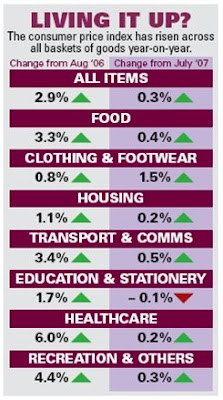
The Associated Press
Chip Colville, owner of Colville's, Inc., checks the mechanical meters on a diesel fuel dispenser at his Chevron service station, Friday, April 25, 2008, in Reardan, Wash. The meters on the 30 plus-year-old dispensers stop at $3.999 per gallon. (AP Photo/Jeff T. Green)REARDAN, Wash. (AP) — Mom-and-pop service stations are running into a problem as gasoline marches toward $4 a gallon: Thousands of old-fashioned pumps can't register more than $3.99 on their spinning mechanical dials.
The pumps, throwbacks to a bygone era on the American road, are difficult and expensive to upgrade, and replacing them is often out of the question for station owners who are still just scraping by.
Many of the same pumps can only count up to $99.99 for the total sale, preventing owners of some SUVs, vans, trucks and tractor-trailers to fill their tanks all the way.
As many as 8,500 of the nation's 170,000 service stations have old-style meters that need to be fixed — about 17,000 individual pumps, said Bob Renkes, executive vice president of the Petroleum Equipment Institute of Tulsa, Okla.
At Chip Colville's Chevron station in this eastern Washington town, where men in the family have pumped gas since 1919, three stubby, gray pumps were installed when gas was less than $1 a gallon. They top out at $3.999, only 30 cents above the price of regular gas at Colville's station.
"In small towns, where you don't have the volume, there's no way you can afford to pay for the replacements for these old pumps," Colville said. "It's just not economically feasible."
The problem is worse in extremely rural areas, where "this might be the only pump in town that people can access," said Mike Rud, director of the North Dakota Petroleum Marketers Association.
Demand for replacements has caused a months-long backlog for companies that make or rebuild the mechanical meters — and that's just for stations that can afford the upgrade.
For many station owners — who, because of relatively small profit margin on gas, aren't raking in money even though gas prices are marching higher — replacing the pumps altogether with electronic ones is just not an option.
"The new ones run between $10,000 and $15,000 apiece," Colville said. "It's an expense that's not worth it."
Mechanical meters can be retrofitted with higher numbers when pump prices climb another dollar. The last time that happened was in late 2005, when gas went over $3 a gallon, and owners of the older pumps installed kits that went to $3.999.
This time around, owners of the old pumps will need to install another kit that can handle prices up to $4.999, and possibly higher. Industry experts say those changes could cost as much as $650 per pump.
It costs less to change the meter to raise the maximum price from $2.99 to $3.99 a gallon, but that option raises the risk of a breakdown, said said Pete Turner, chief operating officer for APS Petroleum Equipment Inc. of Anniston, Ala.
"The computer that they're upgrading was not designed to go any more than what it's going now, and if you do it, they don't last long enough," Turner said. "They run so fast that the gears are wearing out."
The price of fixing the meters jumped in the past three years because old pumps are being phased out for new electronic pumps and demand for refurbished meters is down, Al Eichorn, vice president of PMP Corp., which makes the mechanical meters.
The Avon, Conn., company has hired extra employees who are working overtime but still has a 14-week backlog of orders, Eichorn said.
To deal with the problem, some state regulators are allowing half-pricing — displaying the price for a half-gallon of gas, then doubling the price shown on the meter.
In North Dakota, regulators recently told service stations their mechanical pumps could use half-pricing, provided they use signs to alert costumers and find a permanent solution by April 2009.









